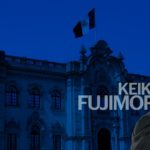Vote by vote: She dreams of becoming the first female president of Peru
The first time the Peruvians set eyes on Keiko Fujimori was on the morning of April 8, 1990. It was a direct broadcast on national television of the breakfast of the surprise candidate in the presidential elections that year. In the general elections in Peru the tradition is for journalists to go en masse to the home or campaign headquarters of the presidential candidates to accompany and follow them to each of the campaign events, the first of which is their breakfast.

Alberto Fujimori, an engineer, ex-professor of mathematics at the National Agriculture University and short-lived host of the "Concertando" (Reaching Agreements) program on national television, had become the surprise element of the elections. Having started out with a tiny percentage of voter preference and always a part of the eccentricities of that campaign, he had recovered and become a potential rival of the candidate who was believed to be the uncontested winner of the elections, the writer Mario Vargas Llosa.
What was shown that day on television and in the papers was a conventional, middle-class Peruvian family in the dining room of a house that was undistinguishable from any other and could be found in any of Lima's neighborhoods in the 1990s. At the onslaught of so many journalists, the 14-year old Keiko demonstrated the shyness that is so appropriate in youngsters at that age.
That was how the eldest of the Fujimori Higushi brothers initiated his role in one of the most important and dramatic moments of modern Peruvian history. Keiko and her siblings Hiro, Sachi and Kenji became public figures after their father was elected president. After finishing her studies in the Sacred Heart school of La Recoleta, Keiko travelled to the United States to study Business Administration at the State University of New York. Her studies were interrupted in 1994 when her parents separated and she had to return to Lima to occupy the honorary position of First Lady, held previously by her mother Susana Higushi.
Since taking on this position at the age of 19, Keiko inherited the functions of President of the Children of Peru Foundation, founded by Pilar Nores in 1985 during the first government of Alan García. However, Keiko promoted her own foundation, the Peruvian Children's Heart Foundation.
Keiko took up her Business Administration studies again from 1995 to 1997 at the University of Boston, where she finally graduated. She also has a Master's Degree in Business Administration, awarded in 2008 by the University of Columbia and a diploma in Democracy, Parliament and Governability awarded by the George Washington University in 2007. It was there that she met Mark Villanella, whom she married in 2005. The couple has two daughters: Kyara Sofía (2007) and Kaori Marcela (2009).
In politics, Keiko Fujimori was in charge of restoring the forces inherited from her father. In 2006 she was elected to Congress and in 2011 she ran for President. After losing to the commander Ollanta Humala in the second round, Keiko campaigned around the country. This time she had the advantage of having spent nearly five years working to become the first female president in the country’s 195 year history as a republic.
However, early official data on the recount of the second round of the elections show she has 1% fewer votes than the candidate Pedro Pablo Kuczynski. Given how close it is and the nearly technical tie, the National Office of Electoral Processes’ (ONPE) final announcement is still awaited.